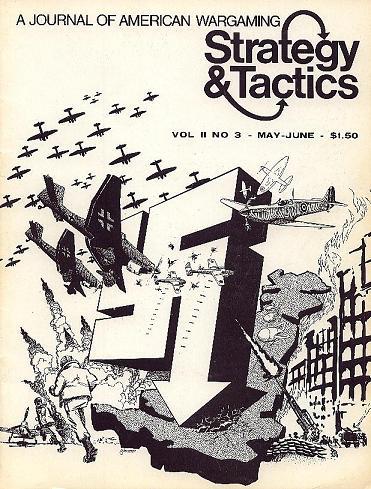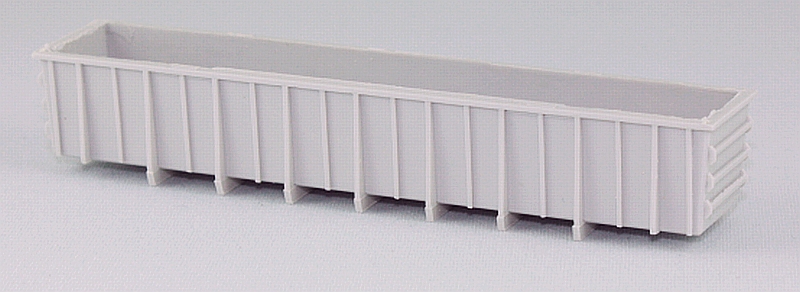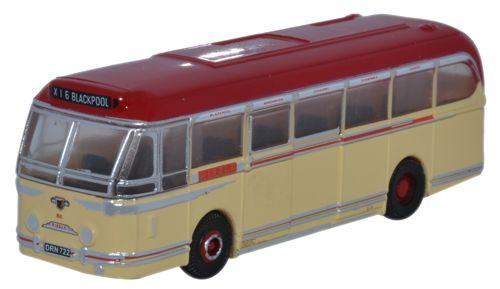Model Information: This model from InterMountain features Micro-Trains trucks with truck-mounted MTL couplers. Etched metal walkways, sharp printing, and excellent detail including seprately applied hoses on the underframe as well as separately applued roof hatches. Unlike the similar Micro-Trains model, the roof hatches do not open. The InterMountain model has superior detail under the bays, though the MTL model is still quite good. Both have the bay releases as separately applied (as opposed to molded) detail parts. The end detail on the IM model also is superior showing hoses from the barrel (to the brake system?).
Prototype History: Production of the 4650-cubic foot 3-bay cars began in 1964. ACF built 2504 examples at Huntington, WV, between 1964 and 1972. The ACF 4650 c.f. 3-bay hopper was the same height and width as the 5250 c.f. 4-bay car but several feet shorter in length (and only had 3 bays!). Some railroads that were not concerned about having the larger plate C clearance 4650cf cars (which could not be used on all branchlines or at all loading facilities) opted for large fleets of 4650cf cars instead of 4600cf. UP and SP were two such railroads (all of the current UP 4600cf cars came from either MP or C&NW heritage).
Hatches: 6 30", 6 20", 3 pressed steel elongated (SP, SSW, 3 piece pressed steel continuous or 4 piece FRP continuous. Outlets: Several types of bolted or welded on outlets are used. Uses: Grain, soda ash, platic pellets. Trucks: 77 ton friction or roller bearing. 86 had 100 ton roller bearing.
Hatches: 6 30", 6 20", 3 pressed steel elongated (SP, SSW, 3 piece pressed steel continuous or 4 piece FRP continuous. Outlets: Several types of bolted or welded on outlets are used. Uses: Grain, soda ash, platic pellets. Trucks: 77 ton friction or roller bearing. 86 had 100 ton roller bearing.
Road Name History: This line was established in 1852 under another name but was renamed Western Maryland Rail Road before the first rail was laid. By 1862 they had built from Baltimore to Union Bridge, Maryland at which point it became the responsibility of the Union Army. Construction resumed after the war. WM built west to Hagerstown then Cumberland where the line spilt in two. One route headed northwest to an important interchange with Pittsburgh & Lake Erie at Connellsville, Pennsylvania. The other line ran southwest into the rich coal fields around Elkins and Durban, West Virginia. On the east end, they also had routes to York and Gettysburg and an important connection with the Reading at Shippensburg, all in Pennsylvania. At 878 miles, WM was between Maine Central and Spokane Portland & Seattle in relative length.
The city of Baltimore had a large stake in the WM but sold it in 1902 to Jay Gould. The Gould empire unraveled just six years later and the WM was reorganized with Railway replacing Rail Road in the name and John D. Rockefeller holding a 43% stake. He sold those shares to Baltimore & Ohio in 1927. Accused of violating antitrust laws, B&O placed those shares in a non-voting trust.
After 1900, WM relied heavily on 2-8-0’s, ordering 177 between 1900 and 1923 (by which time other railroads were already ordering 2-8-2’s.) Some of these Consolidations were real bruisers with the same tractive effort as WM’s 2-6-6-2’s. Also in road service were 30 2-10-0 Decapods (10 Russian Decapods and 20 much larger versions,) a dozen 4-8-4’s to handle the high speed trains, and a dozen 4-6-6-4 Challengers. The Challengers turned out to be a disappointment to WM. They were rough riders and were hard on the track. As a result, they were soon demoted to pusher service alongside WM’s 25 2-8-8-2’s. A fleet of 19 low drivered Pacifics handled most of the passenger assignments. One element found on most of the WM steam fleet was low snowplow pilots in lieu of the traditional boiler tube pilots. WM was one of a few Class One railroads to employ Shay locomotives to serve steeply graded branchlines. WM had one 2-truck, two 3-truck and two 4-truck Shays. Shay #6 built in 1945 was the last Shay built by Lima Locomotive Works.
WM began to dieselize in 1947 on the east end where they would not raise the ire of their coal mining customers on the west end. The diesel fleet was surprisingly varied for a line their size with cab units from both Alco and EMD, road switchers from Alco, EMD and Baldwin and yard switchers from GE, Baldwin and Alco. The road switchers from Alco and Baldwin plus the EMD GP7;s were delivered with the long hood as the front while the EMD GP9’s were delivered with the short hood as the front. The Second Generation of diesels was all EMD.
In addition to the voluminous coal traffic, WM was a part of two bridge routes for merchandise moving between the northeast and the upper Midwest. These were the Alphabet Route (with Nickel Plate Road, Wheeling & Lake Erie, Pittsburgh & West Virginia, Reading and others) and the Central States Dispatch (with Baltimore & Ohio, Reading, Jersey Central, Lehigh & Hudson River and New Haven.) Iron ore also moved from Baltimore area ports to steel mills on the connecting P&LE.
Passenger service was a bit of an afterthought on the WM. Not only did they not have a shiny streamliner, but their heavyweight coach trains lasted only until 1957 before being discontinued. Steam generator equipped hammerhead RS-3’s replaced the Pacifics in passenger service for a few years before being reassigned to freight duty.
In 1967, B&O (by this time controlled by Chesapeake & Ohio) finally obtained permission to take overt control of the WM. Not much changed for the next five years. In 1973 they adopted the Chessie System image and 125 miles of WM mainline was abandoned in favor of trackage rights on a parallel B&O line. In 1983, the Western Maryland was absorbed into the Baltimore & Ohio. Western Maryland was known for frequently washing their locomotives in both the steam and diesel eras. They kept up this tradition until the start of the Chessie System era.
The city of Baltimore had a large stake in the WM but sold it in 1902 to Jay Gould. The Gould empire unraveled just six years later and the WM was reorganized with Railway replacing Rail Road in the name and John D. Rockefeller holding a 43% stake. He sold those shares to Baltimore & Ohio in 1927. Accused of violating antitrust laws, B&O placed those shares in a non-voting trust.
After 1900, WM relied heavily on 2-8-0’s, ordering 177 between 1900 and 1923 (by which time other railroads were already ordering 2-8-2’s.) Some of these Consolidations were real bruisers with the same tractive effort as WM’s 2-6-6-2’s. Also in road service were 30 2-10-0 Decapods (10 Russian Decapods and 20 much larger versions,) a dozen 4-8-4’s to handle the high speed trains, and a dozen 4-6-6-4 Challengers. The Challengers turned out to be a disappointment to WM. They were rough riders and were hard on the track. As a result, they were soon demoted to pusher service alongside WM’s 25 2-8-8-2’s. A fleet of 19 low drivered Pacifics handled most of the passenger assignments. One element found on most of the WM steam fleet was low snowplow pilots in lieu of the traditional boiler tube pilots. WM was one of a few Class One railroads to employ Shay locomotives to serve steeply graded branchlines. WM had one 2-truck, two 3-truck and two 4-truck Shays. Shay #6 built in 1945 was the last Shay built by Lima Locomotive Works.
WM began to dieselize in 1947 on the east end where they would not raise the ire of their coal mining customers on the west end. The diesel fleet was surprisingly varied for a line their size with cab units from both Alco and EMD, road switchers from Alco, EMD and Baldwin and yard switchers from GE, Baldwin and Alco. The road switchers from Alco and Baldwin plus the EMD GP7;s were delivered with the long hood as the front while the EMD GP9’s were delivered with the short hood as the front. The Second Generation of diesels was all EMD.
In addition to the voluminous coal traffic, WM was a part of two bridge routes for merchandise moving between the northeast and the upper Midwest. These were the Alphabet Route (with Nickel Plate Road, Wheeling & Lake Erie, Pittsburgh & West Virginia, Reading and others) and the Central States Dispatch (with Baltimore & Ohio, Reading, Jersey Central, Lehigh & Hudson River and New Haven.) Iron ore also moved from Baltimore area ports to steel mills on the connecting P&LE.
Passenger service was a bit of an afterthought on the WM. Not only did they not have a shiny streamliner, but their heavyweight coach trains lasted only until 1957 before being discontinued. Steam generator equipped hammerhead RS-3’s replaced the Pacifics in passenger service for a few years before being reassigned to freight duty.
In 1967, B&O (by this time controlled by Chesapeake & Ohio) finally obtained permission to take overt control of the WM. Not much changed for the next five years. In 1973 they adopted the Chessie System image and 125 miles of WM mainline was abandoned in favor of trackage rights on a parallel B&O line. In 1983, the Western Maryland was absorbed into the Baltimore & Ohio. Western Maryland was known for frequently washing their locomotives in both the steam and diesel eras. They kept up this tradition until the start of the Chessie System era.
Brand/Importer Information: InterMountain was founded in 1985 by Fred Brummet. They got started in the model railroad business by producing O-Scale model kits. They got started in the N Scale business almost a decade later when in 1994 they introduced the 40-23 reefer car in kit form. Later, in 1998, they started producing RTR (Ready-to-Run) models. By the early 2000s, InterMountain phased out kit production in favor of the RTR models.
The InterMountain Railway company is located at 1224 Boston Ave in Longmont, CO. They are a manufacturer of HO, N and Z scale model trains. They have produced kits as well as RTR (Ready-To-Run) models. Their N Scale products include locomotives as well as rolling stock. Their rolling stock lineup includes Boxcars, Hoppers, Tank Cars, Reefers, Gondolas, Stock Cars and Flatcars.
Their locomotive releases have primarily been diesel units, with the one major exception being their series of AC-12 Cab Forward steam locos. Their diesel lineup includes F3's, F7's, F9's, SD40's, SD45's and FT units. They are known for quality and detail. They also release their rolling stock in larger varieties of road numbers than most of the other manufacturers.
The InterMountain Railway company is located at 1224 Boston Ave in Longmont, CO. They are a manufacturer of HO, N and Z scale model trains. They have produced kits as well as RTR (Ready-To-Run) models. Their N Scale products include locomotives as well as rolling stock. Their rolling stock lineup includes Boxcars, Hoppers, Tank Cars, Reefers, Gondolas, Stock Cars and Flatcars.
Their locomotive releases have primarily been diesel units, with the one major exception being their series of AC-12 Cab Forward steam locos. Their diesel lineup includes F3's, F7's, F9's, SD40's, SD45's and FT units. They are known for quality and detail. They also release their rolling stock in larger varieties of road numbers than most of the other manufacturers.
Item created by: CNW400 on 2021-01-25 10:13:52. Last edited by CNW400 on 2021-01-25 10:17:42
If you see errors or missing data in this entry, please feel free to log in and edit it. Anyone with a Gmail account can log in instantly.
If you see errors or missing data in this entry, please feel free to log in and edit it. Anyone with a Gmail account can log in instantly.











